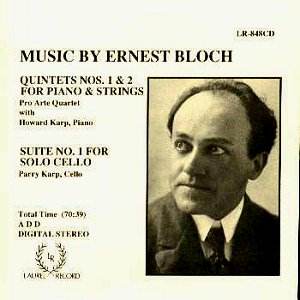Laurel’s dedication to Bloch’s grievously underrated
chamber music has led to some laudable and permanently important additions
to the catalogues, of which this issue proves a strong part. Alongside
another Laurel/Pro Arte release – that of the second Quartet and other
pieces for quartet (LR826 sample
here) – this one proves to be commandingly well realised and to
extend further our understanding of Bloch’s creative processes. The
First Quintet was begun in 1921 and finished two years later. Originally
intended as a cello sonata it was worked up into a more extensive form
and achieves thematic unity through inter-related material as so often
in Bloch. A big work in three movements it opens with motoric suspension
and agitated piano writing, before releasing some uneasy material and
starting up once again, the cello bending notes well as the music returns
to the insistent, unceasing motor. The Andante mistico is full of a
keening depth, becoming increasingly passionate before returning to
the initial sense of mysterious contemplation. Marked Allegro energico
the finale is precisely that in this committed performance – full of
propulsive rhythmic attack and technical flourishes before it too slowly
winds down to static oases of reflective intimacy, and ends, with perfect
judgement of its musical graph, poignantly and quietly.
The Second Quintet of 1957 was written when Bloch realised
that he was suffering from the cancer that was to kill him two years
later. Its dodecaphonic first theme is followed by much intervallic
writing, step up themes, motives that recur, are mulled over; this is
occasionally stern music but never unyielding; its power lies in its
compactness – the opening movement packs in considerable detail but
remains lyrical and forward moving, never clotted. Amidst the rather
lyrical but withdrawn Andante those step themes recur giving thematic
coherence and interrelatedness to the work, adding to the poignancy,
giving weight in amplitude. The finale is the longest of the three movements,
the tritone motif again reappearing, and this time toughness and strong
spirit dominates, the movement occasionally opening out motorically
before the coda, which is a beautiful, though not explicitly emotive,
end to the work; one in which serenity and hard won peace fuse to moving
effect.
Bloch’s last works were a series of six remarkable
compositions for solo strings. These were the three cello suites, the
two suites for violin and the incomplete viola sonata (recorded by Primrose),
and all dating from 1956-58. This First Cello Suite of 1956 was dedicated
to the recently (2002) deceased Canadian cellist Zara Nelsova (as was
the second). Opening in interior fashion it soon grows in lyric intensity
whilst the second movement, an Allegro, features some guttural work
on the lower two strings and a strongly powerful sense of projection.
The Canzona is lyrical and exploits, this time, the upper strings, forlorn
but unselfconscious and deeply attractive whilst the animated finale
is vigorous, stormy and celebratory.
I strongly recommend this Laurel Bloch series in
toto. The Pro Arte Quartet are strongly expressive interpreters
of the genre and these are works very well worth getting to know. And
knowledge will lead to lasting admiration.
Jonathan Woolf
